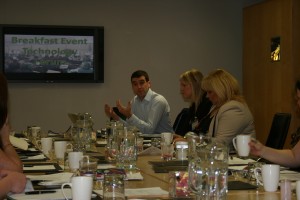![]() December 2012 Etherlive launches Live Event Footfall Analysis technology.
December 2012 Etherlive launches Live Event Footfall Analysis technology.
![]() December 2012 Etherlive hosts another breakfast session for those within the events industry keen to understand technology.
December 2012 Etherlive hosts another breakfast session for those within the events industry keen to understand technology.
![]() November 2012 Etherlive contributes to Conference News event industry forum.
November 2012 Etherlive contributes to Conference News event industry forum.
Since our last Gathering at Somerset House at the beginning of the year we have been keen to bring together a group of experts and corporate event organisers to discuss the latest experiences (good or bad) with technology at events.
This led to the Breakfast Event Technology Form which was held at the Guoman Cumberland Hotel with a group of 25 select attendees sitting discussing some key industry topics over a bacon role and cups of tea. We captured some brief notes from the discussions and links to the tools shown below. To keep the discussion about technology in events going we aim to keep the twitter hashtag #eventtechforum
Venue expectations:
- A key element is appreciating the requirements from the customer. Why do they need the internet? Just basic email and web browsing? Cloud content sharing? Or streaming video? All these questions will drive the requirement with the venue.
- A pre survey with relevant testing hardware (with the same laptops which will be used if possible) to see what the Wi-Fi signal is like and how fast the internet is.
- Agree terms with the venue which specify what performance you need per device connected
- Discuss what happens if something breaks, if it’s critical to your event would you want an engineer to attend?
- Use cable drops for those who require service for demonstrations to reduce the risks. This should be part of the booking contract.
- If required bring in an expert (in house IT teams or companies such as Etherlive) to give some advice on how to improve the onsite facilities if you need to. If budgets are tight look at the entire budget based on how important the internet services are

Etherlive Breakfast Event Technology Forum
Avoid getting bitten by IT
- Many organisers get caught in the same trap – lack of understanding about what the event is trying to achieve, and thus fail to set appropriate expectations for services.
- Ensure you have resource to hand should you need ‘IT’ type support. If budgets don’t allow perhaps one of the in house IT team may be able to support, or perhaps bring in an engineer just for the morning or during the critical presentation.
- Spend time identifying key points of failure and plan for a redundancy. Just like any risk at an event this should be presented to the customer with options of what can be done to mitigate.
- Be aware that some devices (laptops, smartphones) will work differently with Wi-Fi due to the quality of design and parts. Interference (such as human bodies and other radio based systems) may also impact Wi-Fi service.
Budgeting
- Many events do not set a specific budget line item for technology services, however, many now think this should be a mandatory line item even if the Wi-Fi services are included within the day delegate rate
- A good partner will be able to explain their pricing to organisers. If they can’t it may be overly complicated or at worse not considered. Technology can be complicated but the basic principles are simple to explain and present
- Generally the elements that drive cost the most are connectivity and resource. Connectivity generally gets more expensive the later it is booked. Resource costs can often be optimised with setting up on the same day (perhaps avoiding accommodation etc.)
Innovation panel
- Use social media to engage audiences and encourage those not in the room to join in furthering the events exposure and inclusiveness
- Apps deliver content in a very set environment but other options, such as customised websites, can deliver similar content with reduced budgets. Consider what will happen to the content the delegate is looking at if connectivity is lost.
- Free cloud services such as Google Documents can be used to share content including spread sheets, documents etc. allowing multiple editing, different rights and version tracking
Tools
- Scheduling tweets (perhaps for sponsors to have automated announcements during the event http://hootsuite.com/
- Show a stream of tweets during the event http://visibletweets.com
- Free QR generator http://www.qrstuff.com/
In summary a fantastic day to network, meet new contacts and learn. We hope to run similar sessions again in the New Year for others who could not attend this time.
There is one thing that can challenge even the best designed wireless networks; interference. That is, the transmission of competing networks attempting to broadcast at the same time on the same frequency. At the risk of turning this blog into to a science paper we’ll keep it light, but it is interesting to note that we have been in several meetings over the past few weeks where the delivery of Wi-Fi networks has been challenging due to the amount of interference.
As venues and events deploy wireless networks that become ever more critical to delegates, press, production and exhibitors, interference is the elephant in the room. Managing rogue access points, or those using their own solutions is imperative in reducing interference, and ensuring that those who are trying to use Wi-Fi networks in the same place can do so.
Understanding the limitations
Wi-Fi technology is designed to communicate over a number of common frequencies. This allows smartphones, laptops and other client devices to know how to communicate with access points and each other. Within this frequency there are a defined number of channels, similar to the number of lanes on a motorway. The more channels or lanes you have, the more simultaneous networks you can have in operation. 2.4G Hz Wi-Fi networks have significantly less channels than 5GHz networks.

The spectrum crusaders ride to their next rogue access point
Setting expectations
Just like expectations on stand power (i.e. would exhibitors expect to bring their own petrol generator into an indoor venue?), there should be guidelines for use of wireless technology. Those who do not follow the rules should appreciate that their equipment may be turned off since their configuration could potentially impact those around them trying to access and fully utilise the ‘in house’ Wi-Fi. This can be as simple as a form which is completed as part of the contract which asks a few simple questions about which channel their wireless equipment will be broadcasting from.
Watching the air & taking action
Once the expectations have been set, wireless scanners can be used to ensure the agreements are being followed and that those who are causing interference are located. In areas where others are complaining about service, it will be quickly evident who isn’t playing fair. This was carried out during the Olympics and was commonly accepted by exhibitors because the expectations had been set.
One wire to rule them all
Many venues would also suggest that exhibitors who need a ‘guaranteed’ service should have a wired connection and that is absolutely correct. In addition to interference, some wireless chips are better than others and some devices just have bad days, so if the device supports a cable and it’s practical to do so, then this is highly advised. However, as more and more demonstrations rely on tablet computers (especially with the new Microsoft Surface launch), wireless will be considered critical to some stands.
![]() October 2012 Etherlive continues to focus on innovation and launches new partnership.
October 2012 Etherlive continues to focus on innovation and launches new partnership.
As the summer of sport runs into the sunset suddenly the September of phones is upon us. Two big announcements means this is a really important month (and quarter) for a technology which has become intrinsic to either attending or producing events.
4G is Go? – Wait and See
After more manoeuvring than a telehandler placing toilets (see our previous blog posts) 4G services will finally begin deploying in the UK. The first to market will be Everything Everywhere (a combination of the Orange and T-Mobile networks) which announced on Tuesday networks firing up in London, Birmingham, Cardiff and Bristol within weeks with more cities expected to follow before Christmas. Long Term Evolution (or LTE) brings a number of significant improvements over current 3G networks including download speeds of up to 20Mbps, improved algorithms for handoff between mobile cells (which should mean less dropped calls) and in some cases larger cell sizes meaning better coverage.
It all sounds great, however, there should always be a note of caution when dealing with cellular services which is probably best expressed by matching todays “3G” experience with what happens in the real world. Do you live in a world where your handset always has 3G signal, you haven’t dropped a call in months, data use is reliable, network masts never fail and when you are trying to text or call the box office during a live event with 20,000 other people on site it works first time? – The answer is carriers always sell the dream of the next generation; 4G is exactly the same. In reality what you should expect to start with is what was promised for 3G, meaning OK to good data speeds in cities and calls which rarely drop. Also lest we forget 4G, like 3G before it, is a consumer focussed technology offering which means very little in the way of speed guarantees or service up time.
Of course unfortunately for events the same problems around delivering reliable service to a remote location with high density usage will continue to be a challenge – not helped by the next big thing in cellular this month…
iPhone 5 – A monster awakes.
You can’t have missed the press, Apple’s latest iPhone 5 was announced last night. Those in the know will point out that even with this latest incarnation Apples crown has slipped slightly with handsets from Samsung and Blackberry winning in the specification war but that’s missing two crucial factors which need to be considered when dealing with anything from Cupertino. The first is the tidal surge of press and activity that follows anything iNew generating floods of new apps and ways to use the device, many of which rely on the iPhones killer selling point; the lack of learning curve. The second is the new technology which is bound up in this latest generation which includes the ability to operate with the new 4G networks, a new screen to show that high definition content even clearer (which means larger network downloads and faster streams required) and an all new software pack which further integrates social networking and always on connectivity. In addition Apple has given the iPhone one of the best features of the iPad which is its ability to work on both 2.4Ghz networks and 5Ghz which makes getting a good Wi-Fi signal, and keeping it, even easier.
That reliance on faster and always on connectivity will continue to keep demand growing for events who can deliver apps which enjoy video and interactive content at events.
Where Apple has missed a trick perhaps is the lack of contactless payment function others (such as Samsung and Blackberry) have started to deploy this latest technology which will put pressure on retailers of all sorts to start supporting the quick payment method. Apple is probably waiting for the market to settle before setting out it’s stall (and – knowing Apple – where it’s revenue stream is going to come from) but those early adopters will expect to be using their contactless payment methods this summer – we have another blog in a few weeks on this and our activity over the summer.


